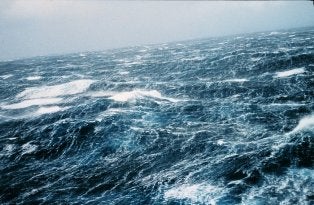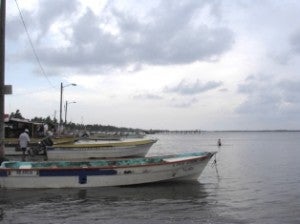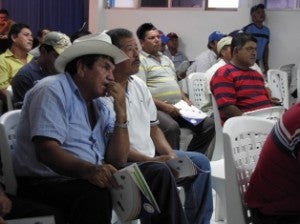The fisherman’s story of frustration with compliance issues under the Sinaloa Shrimp fishery catch share was what I and two of my colleagues continuously heard during our outreach trip in Mexico in July. After spending a month in fishing camps along the Sinaloa coast giving presentations on catch shares and facilitating other exercises to communicate and dissect the issues of fishery management, we believe the fishermen we reached now understand that achieving success through catch share management will take efforts from all the stakeholders: NGOs, government, and most importantly the fishermen themselves.
Although it is easy to become frustrated with the challenges of implementing a new fishery management program, we stressed that real lasting change will take time and that our workshops aimed to empower fishermen to begin solving their own problems with compliance.
One thing that has always interested us is what type of management fishermen would implement if they could choose. To find this out, we played a “fishing game” with three rounds that mimic the problems in the fishery for both the fishermen and the authorities, while inviting fishermen to solve these issues using their own knowledge.
The first round represents the race to fish; the second round a command and control management, and in the third round the fishermen themselves are allowed to make up their own rules. In many cases the third round resulted in some form of catch shares. In response, we communicated that although the realities fishermen face are bleak, without their participation and compliance we will never see the third round in reality.
Implementing catch shares in Mexico has many challenges, and illegal fishing is one main roadblock. In 2009, a historic year for fisheries in Mexico, a TAC was set and shares were allocated for the artisanal blue shrimp fishery. NGOs and government were working together to improve fishery management, something rare in any country.
Though in a land where the laws are written well but commonly disobeyed, it has become clear that with catch shares the story is no different. For this reason it has been of utmost importance for us to maintain contact with the fishermen and continue our presence on the ground. Adaptive management and design continues to be our motto as we work with fishermen to implement innovative solutions and design to confront these challenges.
During our trip, I was a proud catch share cheerleader, and for this shrimp season in Sinaloa we have restored the faith in many fishermen that catch shares equals change. Now we must continue to work with fishermen to help design solutions that will turn theory into practice and implement innovative enforcement programs, which will reward those who are part of a catch share and gather their support as advocates and better stewards of their resource.
Never miss a post! Subscribe to EDFish via a email or a feed reader.
All content is copyrighted. Please do not republish without written permission from Environmental Defense Fund.













